Samos › Theogony » Ancient origins
Articles and Definitions › Contents
- Samos › Ancient History
- Theogony › Antique Origins
Ancient civilizations › Historical and archaeological sites
Samos › Ancient History
Definition and Origins
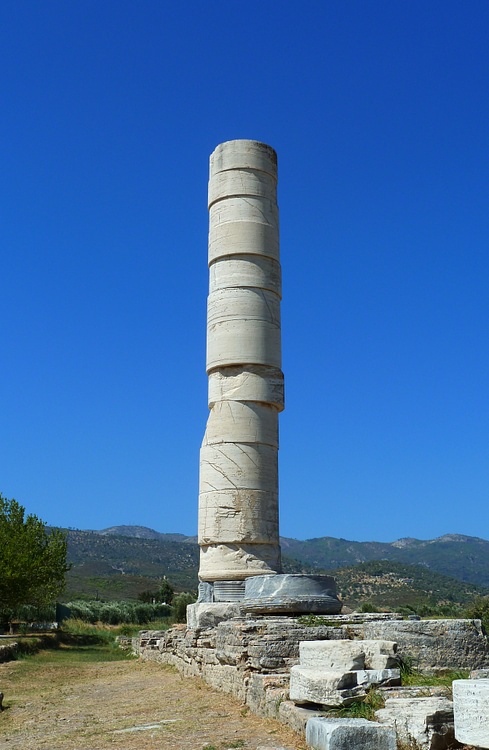
Samos is a Greek island in the east Aegean, just off the coast of modern-day Turkey. It particularly flourished in the 6th century BCE and was famous in antiquity for its navy, wine, and important sanctuary to Hera. Samos was an active member of the Delian League and the celebrated philosopher and mathematician Pythagoras was born there, as was the famed astronomer Aristarchus. Hosting both Julius Caesar and Mark Antony in the 1st century BCE, the island then slipped quietly into obscurity during the Roman imperial period.
EARLY SETTLEMENT
Samos was first occupied in the Neolithic period, and a late Bronze Age presence is attested by Mycenaean remains.Carians followed next in the 10th century BCE. The Greeks themselves recorded that in the Archaic period colonists arrived from Ionia. According to Thucydides those settlers themselves had originally come from Attica. A city was founded in the south-east of the island as Samos benefitted from arable mountain slopes and fertile plains. Wine and olive oil were exported and transported in amphorae distinctive to the island. The island's prosperity is further evidenced by the monumental stone architecture constructed from the 8th century BCE. The famed sanctuary of Hera (Heraion), built in honour of the island's patron during the reign of the tyrant Aeaces, was located 8 km from the main city.
From the 7th century BCE, Samos maintained a naval fleet with help from its ally Corinth. The ships were built using wood from its thick forests. This navy, one of the largest in Greece, would eventually be composed of the famous trireme warships which had three banks of rowers and a bronze battering ram on the prow. As the island prospered so it participated in the general wave of Greek colonization. Samos established colonies in Cilicia, the Propontis, and the Black Sea. In northern Africa, the island also co-founded Cyrene and built a temple at Naucratis.
DURING THE REIGN OF POLYCRATES SAMOS PARTICULARLY FLOURISHED, CONTROLLING THAT PART OF THE AEGEAN & THE CYCLADES WITH 100 WARSHIPS.
POLYCRATES THE TYRANT
During the reign of Aeaces' son, Polycrates (c. 535-522 BCE), Samos particularly flourished, controlling that part of the Aegean and the Cyclades with its 100 warships and the help of its Egyptian ally Ahmose II. The city also gained a reputation as a cultural centre, attracting poets such as Anacreon and Ibycus, and was home to the famous architect Theodorus. At this time, Samos benefitted from an enlarged temple to Hera (the largest ever according to Herodotus ), a 365 m long harbor mole, and fortifications. A tyrant is perhaps always a tyrant though (even in the Greek sense), and the famous philosopher and mathematician Pythagoras was one who felt compelled to leave Samos. In 522 BCE, as Persia took a greater interest in the region, the island was taken over by the Persian satrap Oroites and Polycrates was crucified. Things did not improve during the Ionian Revolt when those states attempted to break free of Persian rule. Samos was defeated at the battle of Lade in 494 BCE and, according to Herodotus, many of the island's elite fled to Sicily.
THE DELIAN LEAGUE
In 478 BCE Samos became a member of the Delian League. As the League gradually transformed into the Athenian empireand members were compelled to pay tribute, some sought to leave and Samos was one such disaffected city-state in the 440's BCE. However, Athens, at the time led by Pericles, besieged the island c. 440 BCE and forced Samos to remain, extracting a significant fine from the island. From that time on Samos had a pro-Athenian elite running the government and the island became one of the most important League members, supporting Athens throughout the Peloponnesian War.Alcibiades, for example, made a base of Samos in 407 BCE. The people of Samos were even given the privilege of Athenian citizenship in 405 BCE and there was a brief system of democracy. When Sparta won the war, the city claimed control of Samos with the establishment of a rule of ten pro-Spartan oligarchs set up by Lysander. In 366 BCE Athens won the island back and exiled a large portion of the population.
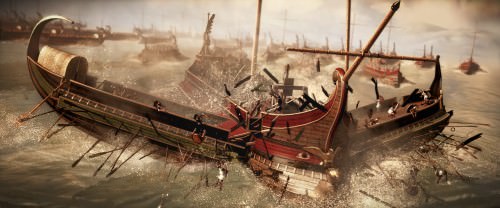
Trireme Ramming
HELLENISTIC & ROMAN PERIODS
In 322 BCE, at the end of the Lamian War between Macedon and a Greek coalition led by Athens, the island became independent. Catching the eye of several rulers during the Successor Wars, Samos eventually came under the control of the Ptolemies of Egypt from 281 BCE. There followed a period of re-building of both the city and the Heraion. As so often, with political stability came cultural endeavor, and the famous astronomer Aristarchus formed his influential theories. From 246 BCE a Ptolemaic fleet used Samos as a permanent base. In 205 BCE the island was taken over by Philip V of Macedon, lost again and re-taken in 201 BCE before returning to the Ptolemies. From 197 BCE Samos came under the jurisdiction of Rhodes.
After supporting the Romans in their wars against Antiochus, the island was given its independence in 188 BCE. In 129 BCE the island became part of the Roman province of Asia. A century of prosperity was brought to an end in 39 BCE when Mark Antony sacked the island; both he and Caesar used the island as a base during the civil wars that ended the Roman Republic. Emperor Augustus made Samos a free city again, but independence lasted only for a century until the reign of Vespasian. Even if the Romans brought benefits such as public baths and basilicas, Samos was now a provincial back-water.It became part of the provincial insularum group of Aegean islands during the reign of Diocletian, and finally, in the Byzantine period, it came under the jurisdiction of the Cyclades.
THE HERAION
The cult of Hera on Samos dates back to Mycenaean times when a stone altar was set up in honour of the goddess. Hera was the patron of Samos, and in Greek mythology she was born there, daughter of Cronus and Rhea. The site became more grandiose over the next few centuries until the first substantial temple was built in the sacred complex known as the Heraion.This temple was one of the earliest in Greece to use stone. The 7th century BCE saw more additions and a wooden wallenclosed the site. In 570-560 BCE an all new limestone temple, much larger than its predecessor, was constructed by two noted architects, Rhoikos and Theodoros. Measuring 52.5 x 100 metres and with columns 18 metres high, it had a wooden entablature and tiled roof. Unfortunately, only a few years after its completion, the temple was destroyed by an earthquake.
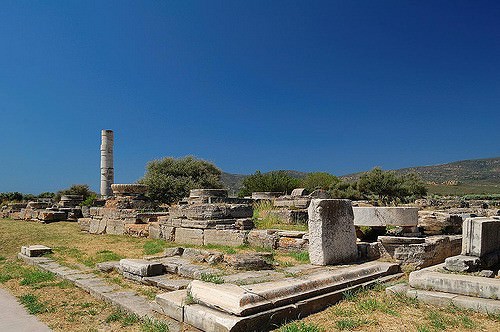
Heraion, Samos
A new temple was built during the reign of Polycrates (although perhaps never fully completed), slightly larger than before, measuring 55 x 108 metres. It had 20 metre high columns on all four sides, 155 in total. The temple was built using limestone but, this time, the columns were carved in marble. One lone column still stands at the site today. The place of ritual was a massive rectangular altar placed outside the temple measuring 36.5 x 16.5 metres. The limestone altar was surrounded by a wall, up to 7 metres in height, which carried relief scenes depicting animals and sphinxes. In the Roman period the altar was replaced by a marble version, and in the 2nd century CE a small temple was added to the site (7.4 x 12 metres), dedicated to an unknown deity. In the 3rd century CE another temple was added and the sacred way, which led to the city proper, was paved. Gradually, as the cult of Hera declined, the site was encroached upon by private houses and villas. The Heraion was destroyed by an earthquake in 262 CE and shortly after was sacked by Germanic tribes. A brief revival occurred in the 5th century CE when a basilica was built at the site, which had three aisles and which recycled material from the earlier buildings.
ARCHAEOLOGICAL REMAINS
Samos has several other architectural features of interest. The first is the 1 km long tunnel constructed by Eupalinus of Megara in the 6th century BCE, which functioned as an aqueduct and carried water to the city. The mole built by Polycrates survives, as do parts of the fortifications built in the same period. Areas of the city have been excavated revealing paved roads, drainage systems, large villas with mosaic floors, shops, and ordinary housing. A large mid-6th-century BCE kouros (naked male youth) statue has also been recovered from the site along with several other large votive statues. These are presently housed in the on-site archaeological museum.
Theogony › Antique Origins
Definition and Origins
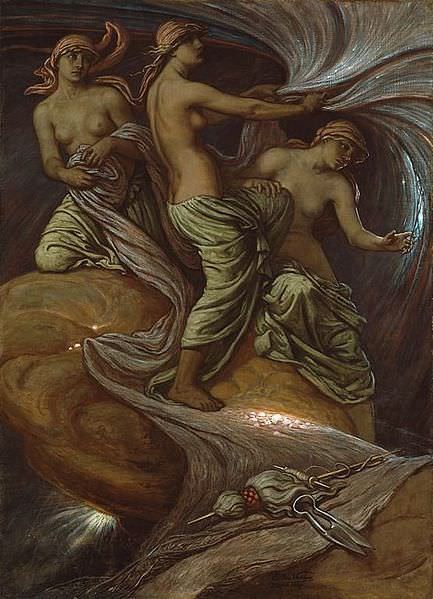
The Theogony is an 8th-century BCE didactic and instructional poem, credited to the Greek poet Hesiod. The Theogonywas, at first, not actually written down, rather, it was part of a rich oral tradition which only achieved written form decades later.The Theogony traces the history of the world from its creation through the battle between the Olympians and the Titans to the ascension of Zeus as the absolute ruler of all of the Olympian gods. With the rise of Zeus to supremacy and the birth of his many children, the poem ends and does not address the continued struggles between mankind and the gods. Much of what is known today concerning early Greek mythology comes from Hesiod's work and that other great Greek poet Homer.Collectively, their works would serve as a major influence on later Greek literature and drama, and Roman mythology, especially through the epic Metamorphoses by Ovid.
AUTHORSHIP
The Theogony (from the Greek theogonia, meaning "generations of the gods") is an epic poem of 1,022 hexameter lines which describes the birth of the gods in the Greek pantheon. It is thought to have been composed c. 700 BCE (give or take a generation either side of that date). Little is known of Hesiod's life. His father emigrated from Cyme in Asia Minor and settled in Boeotia, a small state in central Greece. It is assumed that the poet was a farmer; a fact garnered from the early verses of the Theogony. He may also have been a rhapsodist, a reciter of poetry, where he learned the technique and vocabulary of heroic songs.
Although there are some who question whether or not Hesiod actually wrote the Theogony, most classicists believe he did.However, parts of the work may have been added by later poets and there is a definite similarity in some aspects to earlier Mesopotamian literature. The historian Dorothea Wender believes that the Theogony was an earlier work than Works and Days, the other work attributed to Hesiod. She considers the latter to be a better work, and while the Theogony seems to be unpolished, the author could have had difficulty with written composition.
HESIOD WAS INFLUENTIAL ON CLASSICAL GREEK LITERATURE & PHILOSOPHY, HIS PROMETHEUS STORY, FOR EXAMPLE, INSPIRING SUCH PLAYWRIGHTS AS AESCHYLUS.
Wender criticizes Hesiod for not discussing the dethroning of Kronos and his endless mention of "colourless deities." Also, Hesiod's Zeus is too invincible. There is no suspense. "Homer gets more excitement out of a footrace than Hesiod does out of a full-scale war in heaven" (18). However, to Wender, the poem still has historical interest. Certainly, the Theogony was influential; the historian Norman Cantor in his Antiquity wrote that the Greeks adopted Homer and Hesiod's notion of the gods and
a distinctive Greek religion was developed. This religion was always complex and never consistent in all its details; still, its view of man and the world lies at the center of Greek culture. (123)
Hesiod was influential on Classical Greek literature and philosophy, his Prometheus story, for example, inspiring such playwrights as Aeschylus (c. 525 - c. 456 BCE). His poetic style was much imitated, particularly in Hellenistic times and in Roman times - both the Republic and Imperial Rome - when Hesiod's works continued to be recited and set to music. The great Roman writer Ovid (43 BCE - 17 CE) would use many of the themes of the Theogony in his Metamorphoses.
 PORTRAIT OF HESIOD
PORTRAIT OF HESIOD

HOMER VS HESIOD
In the introduction to her translation of the Theogony, Wender compared the gods of Homer to those of Hesiod. Although Homer's Olympians may not have been admirable ethically - they lied, cheated, and stole - they were still civilized. Homer erased their sins with no mention of any "primitive behavior." However, Hesiod made no effort to "whitewash the mythological past in terms of modern standards with one exception. The exception is Zeus, the hero of the poem, whose omniscience, power and justice are stressed at every opportunity" (17). Homer's epics were written for an upper-class audience while Hesiod's works were more pedestrian. In addition, "… Hesiod has allowed his world of primitive gods and chaotic forces to remain primitive and chaotic" (17).
HYMN TO THE MUSES
In the opening lines of the poem, Hesiod gives credit to the nine Muses, who came to him while he was tending his sheep, for having taught him to sing. Speaking of himself in the third person, Hesiod wrote:
The Muses once taught Hesiod to sing
Sweet songs, while he was shepherding his lambs
On holy Helicon; the goddesses
Olympian, daughters of Zeus who holds
The aegis, first addressed these words to me:
'You rustic shepherds, shame: belies you are
Not men!' (23-24)

Clio
However, Hesiod adds that while man knows enough to make up convincing lies, he still has the skill to speak the truth when needed. The Muses gave him a staff from a blooming laurel and
breathed a sacred voice into my mouth
With which to celebrate the things to come
And things which were before. (24)
He was instructed by the Muses to speak of those who will "live forever." Hesiod, thus, paid homage to the gods with a hymn to the nine Muses who had told the poet of times past. It was a time before the days of Zeus when the earth was born out of Chaos. They spoke of the rise of their father Zeus to the throne on Mount Olympus after his defeat of his own father, Kronos (Cronus):
We start then, with the Muses, who delight
With song the mighty mind of father Zeus
Within Olympus, telling of things that are
That will be, and that were, with voices joined
In harmony. The sweet sound flows from mouths
That never tire; the halls of father Zeus
The Thunderer, shine gladly when the pure
Voice of the goddesses is scattered forth. (24)
Hesiod continues by hearing how the Muses celebrated both the "august race of the first-born gods" and Zeus, the father of both the gods and men. They tell him how Zeus eventually defeated Kronos and divided power among the other gods, most significantly with his brothers Poseidon and Hades. Hesiod tells of how Zeus became supreme,
for he had beaten his father, Kronos, by force
And now divided power among the gods
Fairly, and gave appropriate rank to each. (25)
 KRONOS/SATURN
KRONOS/SATURN

BIRTH OF THE GODS
After the hymn to the Muses, Hesiod describes the birth of the gods. He asks the Muses to "give me sweet song" to tell
how the gods and earth arose at first
And rivers and the boundless swollen sea
And shining stars, and the broad heaven above
And how the gods divided up their wealth
and how they shared their honours, how they first
Captured Olympus with its many folds. (26)
They spoke of Chaos and how from Chaos came night and day. From Chaos came Earth (Gaia) who bore Heaven or Sky (Ouranos) as well as other children including Eros (Desire), Tartarus (Underworld), Erebus (Darkness), and Nyx (Night). From Nyx would come Doom, Dreams, Discord, Blame, and Sleep.
Hesiod speaks of how Nyx also gave birth to the Destines and the merciless Fates,
who track down the sins of men
And gods, and ever cease from awful rage
Until they give the sinner punishment. (30)
However, from the "marriage" of Earth and Sky came the "crooked-scheming Kronos," the enemy of his father. All of the sons of Earth and Heaven - who would become known as the Titans - were hated by their jealous father from the moment of their birth. After each child was born, Ouranos would hide the babe deep in the Earth away from the light. However, their grief-stricken mother had a plan to repay his wicked crime. One evening, when Ouranos approached his wife, a hiding Kronos emerged and took a long-bladed sickle (given to him by his mother) and castrated his father. The dripping blood gave birth to both the Furies and the Giants. The severed genitals were thrown into the sea from which Aphrodite, the goddess of love, was born.

The Birth of Aphrodite
Aside from the rise of Zeus and the battle with the Titans, much of the poem is spent on the birth of a variety of minor deities, among them Protho, Eukrante, Thetis, Hippothoe, and Cymtolge. Hesiod also tells of the marriage of Thaumas and Electra, who gave birth to the Harpies. Hesiod then speaks of the Gorgons and Medusa,
…she who suffered painfully
Her sisters were immortal, always young
But she was mortal, and the Dark-haired one. (32)
According to legend, Medusa would die at the hands of Perseus (another son of Zeus), and when he severed her head,
… great Chrysaor sprang out
And Pegasus the horse, who is so called
Because his birth near to Ocean's springs. (32)
The poet speaks of the "unspeakable Cerberus,"
who eats raw flesh
The bronze-voiced hound of Hades, shameless, strong
With fifty heads. (33)
He wrote of the Hydra, Chimera, and the Nemean lion that would be defeated by the hero Hercules, the son of Zeus. Then there was the birth of Hekate ( Hecate ) daughter of Phoebe and granddaughter of the Titans,
who, above all
Is honoured by the son of Kronos, Zeus
He gave her glorious gifts: a share of earth
And of the barren sea. In starry heaven
She has her place, and the immortal gods
Respect her greatly. (36)
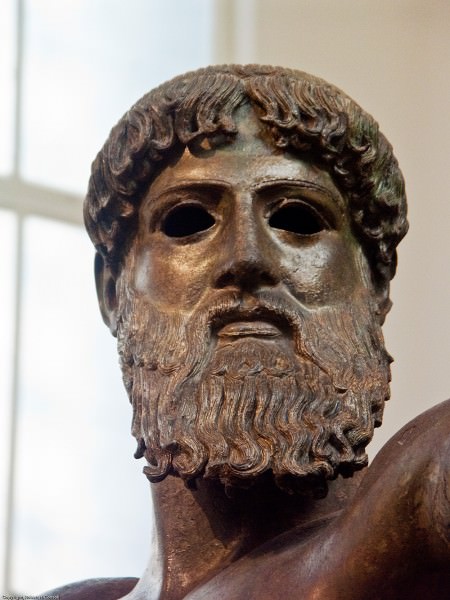 ZEUS
ZEUS

ZEUS & KRONOS
Finally, Hesiod comes to the birth of Zeus:
...father of gods and men
Whose thunder makes the wide earth tremble. (38)
Rhea next gave birth to Hestia, Demeter, Hera, and Hades,
who has his home beneath the earth
The god whose heart is pitiless, and him
Who crashes loudly and who shakes the earth. (38)
However, Kronos seized each child and swallowed them, except, of course, Zeus who was stolen away by his mother to be reared in secret on the island of Crete. Kronos had learned from Earth and Heaven that his destiny was to be overthrown by one of his own. He believed that no one should be superior to the gods except himself. After the future king of the gods returned from his hiding place, he would rise up against his father and castrate him. Wender wrote that Hesiod did not dwell on Zeus's attack of his father - not mentioning the castration - for he did not want the hero of the poem to demonstrate disrespect of a parent.
ATLAS & PROMETHEUS
Later, the poet introduces other notable figures of Greek mythology such as the offspring of the Titans. One of these, Atlas,
forced by hard necessity
Holds the broad heaven up, propped on his head
And tireless hands, at the ends of Earth. (39)

Hercules and Atlas
Next, there was the birth of the "brilliant" Prometheus. However, Prometheus had angered the mighty father of the gods. He had tried to deceive Zeus and had stolen a ray of fire and given it to humanity, but Zeus did not want them to have fire. For this deception, the great god would have his revenge, and Prometheus
was bound by Zeus
In cruel chains, unbreakable, chained round
A pillar, and Zeus roused and set on him
An eagle with long wings, which came and ate
His deathless liver. But the liver grew
Each night, until it made up the amount
The long-winged bird had eaten in the day. (40)
Hercules, son of Alcmene and Zeus, would later free Prometheus from his chains.
THE FIRST WOMAN
In another important, if blatantly misogynistic episode, a young woman is created. Although not named, she was dressed by Athena in silver robes and from her
comes all the race of womankind
The deadly female race and tribe of wives
Who live with mortal men and bring them harm
No help to them in dreadful poverty
But ready enough to share with them in wealth. (42)
Later Greek mythology speaks of Pandora, the wife of Epimetheus, who opens Pandora's Box, an act that brought evil to the world. However, Pandora, by name, is not mentioned until Hesiod's later work, the Works and Days. Hesiod wrote that a woman was bad for a man because she conspires. If a man avoids marriage and the difficulties it brings, he will be miserable in his old age because there will not be anyone to care for him; his relatives will divide his property upon his death. However, a married man with a good wife gets both good and bad but lives his entire life in everlasting pain.
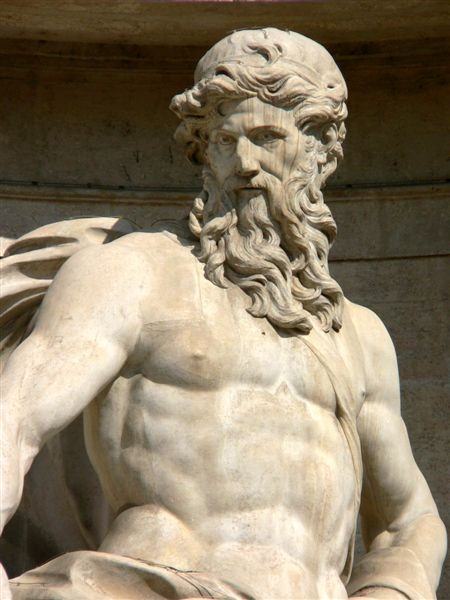
The Titan Oceanus
THE BATTLE WITH THE TITANS
Long ago, a jealous and envious Ouranos had bound three of his sons - the Giants Kottos, Gyes, and Briateus - and
made them live beneath the broad-pathed earth
And there they suffered, living underground
Farthest away, at great earth's edge; they grieved
For many years, with great pain in their hearts. (43)
However, Zeus was able to free them and a battle ensued between the Olympian gods, helped by the Giants, and the Titans.The war between the gods of Olympus and the Titans would last for ten years.
They joined in hateful battle, all of them
Both male and female. Titan gods and those
Whom Kronos sired and those whom Zeus had brought
To light from Erebos. Beneath the Earth
Strange, mighty ones, whose power was immense. (45)
The battle continued until
Zeus no longer checked his rage, for now
His heart was filled with fury, and he showed
The full range of his strength. (45)
The Titans were defeated and sent to Tartarus deep beneath the earth. Those Giants Zeus had freed and fought alongside the Olympians were rewarded for their loyalty.
THE CHILDREN OF ZEUS
The remainder of the poem is concerned with Zeus and the birth of his many children. His first wife was Metis, who bore him Athena. With Leto, he sired the twins Apollo and Artemis, the huntress. With Hera, his sister, Hebe, Ares, and Eileithuia were born. To Hera, "without the act of love" the limping god Hephaistos was born. From Mnemosyne came the nine Muses: Clio, Euterpe, Thalia, Melpomene, Terpsichore, Erato, Polyhymnia, Urania, and Calliope. After mentioning the many sons and daughters of Zeus's offspring Hesiod ends his poem by saying,
These are the goddesses who lay with men
And bore them children who were like the gods
Now sing of women, Muses
You sweet-voiced
Olympian daughters of aegis-bearing Zeus. (57)
LICENSE:
Article based on information obtained from these sources:with permission from the Website Ancient History Encyclopedia
Content is available under License Creative Commons: Attribution-NonCommercial-ShareAlike 3.0 Unported. CC-BY-NC-SA License